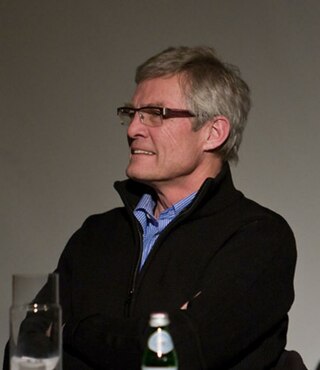Related Research Articles
Roy Kenzie Kiyooka was a Canadian painter, poet, photographer, arts teacher.
Nina Raginsky, is a Canadian photographer who received the honour of the Order of Canada in 1984.
George Steeves is a Canadian art photographer noted for his highly personal work. He has been called by art historian and curator Martha Langford, "among the foremost figures of contemporary Canadian photography."

Evergon, also known by the names of his alter-egos Celluloso Evergoni, Egon Brut, and Eve R. Gonzales, is a Canadian artist, teacher and activist. Throughout his career, his work has explored photography and its related forms, including photo-collage, instant photography, colour photocopying, and holography.

John O'Brian is an art historian, writer, and curator. He is best known for his books on modern art, including Clement Greenberg: The Collected Essays and Criticism, one of TheNew York Times "Notable Books of the Year" in 1986, and for his exhibitions on nuclear photography such as Camera Atomica, organized for the Art Gallery of Ontario in 2015. Camera Atomica was the first comprehensive exhibition on postwar nuclear photography. From 1987 to 2017 he taught at the University of British Columbia, Vancouver, where he held the Brenda & David McLean Chair in Canadian Studies (2008-11) and was an associate of the Peter Wall Institute for Advanced Studies. O'Brian has been a critic of neoconservative policies since the start of the Culture Wars in the 1980s. He is a recipient of the Thakore Award in Human Rights and Peace Studies from Simon Fraser University.
Lorna Brown is a Canadian artist, curator and writer. Her work focuses on public space, social phenomena such as boredom, and institutional structures and systems.
Max Dean is a Canadian multidisciplinary artist.
Penny Cousineau-Levine is a Canadian photography theorist, curator, artist and professor.
Honor Elizabeth Kever is a Canadian artist.
Nicole Jolicoeur (1947) is a Canadian artist from Quebec, best known for her work in photography and video. In the late 1980s, much of her work was inspired by research into Jean-Martin Charcot's theories on feminine "hysteria."
Nancy Tousley is a senior art critic, journalist, art writer and independent curator whose practice has included writing for a major daily newspaper, art magazines, and exhibition catalogues.
Skeena Reece is a Canadian First Nations artist whose multi-disciplinary practice includes such genres as performance art, "sacred clowning," songwriting, and video art. Reece is of Cree, Tsimshian, Gitksan, and Métis descent.
Judith Eglington is a Canadian photographer and filmmaker.
Barbara Spohr (1955–1987) was a Canadian photographer.
Sylvie Readman is a Canadian photographer.
Ron Benner is an internationally recognized Canadian artist whose longstanding practice investigates the history and political economics of food cultures. He is also a gardener and writer who currently lives and works in London, Ontario.
Holly King is a Canadian artist based in Montreal, known for her photographs of constructed landscapes. She views landscape as a product of the imagination.
David T. Alexander is a Canadian painter, known for breathing new life into the landscape tradition of Canada as well as for working in a serious and ambitious manner to reinvigorate the contemporary practice of landscape painting.
Michel Lambeth was a Canadian photographer. He made an in-depth photographic study of Toronto during the 1950s and was one of the country's leading photo-journalists during the 1960s.

Photographs have been taken in the area now known as Canada since 1839, by both amateurs and professionals. In the 19th century, commercial photography focussed on portraiture. But professional photographers were also involved in political and anthropological projects: they were brought along on expeditions to Western Canada and were engaged to document Indigenous peoples in Canada by government agencies.
References
- ↑ "Sandra Semchuk". National Gallery of Canada . Archived from the original on 2016-11-12. Retrieved 2016-11-12.
- 1 2 3 Bassnett, Sarah; Parsons, Sarah (2023). Photography in Canada, 1839–1989: An Illustrated History. Toronto: Art Canada Institute. ISBN 978-1-4871-0309-5.
{{cite book}}: CS1 maint: multiple names: authors list (link) - ↑ "Sandra Semchuk: How far back is home… - Presentation House Gallery". Archived from the original on 2016-10-19. Retrieved 2016-11-12.
- ↑ "Grants | Canadian First World War Internment Recognition Fund | 202-952 Main Street, Winnipeg, Manitoba, R2W 3P4 | Phone: 204-589-4282 | Toll Free: 1-866-288-7931". www.internmentcanada.ca. Archived from the original on 2021-03-03. Retrieved 2021-09-25.
- ↑ Cousineau-Levine, Penny. Faking Death: Canadian Art Photography and the Canadian Imagination. Montreal: McGill-Queen's UP, 2003.DèsLibris Canadian Electronic Library. McGill-Queen's University Press, 1 June 2004. Web. 17 Sept. 2016. p. 65
- ↑ Cousineau-Levine, Penny. Faking Death: Canadian Art Photography and the Canadian Imagination. Montreal: McGill-Queen's UP, 2003.DèsLibris Canadian Electronic Library. McGill-Queen's University Press, 1 June 2004. Web. 17 Sept. 2016. p.218
- ↑ Cousineau-Levine, Penny. Faking Death: Canadian Art Photography and the Canadian Imagination. Montreal: McGill-Queen's UP, 2003.DèsLibris Canadian Electronic Library. McGill-Queen's University Press, 1 June 2004. Web. 17 Sept. 2016. p. 220
- 1 2 Cousineau-Levine, Penny. Faking Death: Canadian Art Photography and the Canadian Imagination. Montreal: McGill-Queen's UP, 2003.DèsLibris Canadian Electronic Library. McGill-Queen's University Press, 1 June 2004. Web. 17 Sept. 2016. p.223
- ↑ missnesbitt (22 December 2014). "Residential school trauma and healing: the art of James Nicholas & Sandra Semchuk". Archived from the original on 19 October 2016. Retrieved 12 November 2016.
- ↑ Kunard, Andrea, and Carol Payne. The Cultural Work of Photography in Canada. Montreal: McGill-Queen's UP, 2011. Print.
- ↑ Dowell, Kristin (Spring 2017). ""Residential Schools and "Reconciliation" in the Media Art of Skeena Reece and Lisa Jackson"". Studies in American Indian Literatures. 29: 116–138. doi:10.5250/studamerindilite.29.1.0116. S2CID 164907414.
- 1 2 3 4 Semchuk, Sandra. Coming to Death's Door: A Daughter/father Collaboration: October 19 to November 24, 1991, Presentation House Gallery. North Vancouver, BC: Gallery, 1992. Print.
- ↑ "Sandra Semchuk". art-history.concordia.ca. Archived from the original on 2008-03-29. Retrieved 2016-11-12.
- ↑ "The Stories Were Not Told". Archived from the original on 2021-01-18. Retrieved 2021-09-25.
- ↑ "Sandra Semchuk: How Far Back Is Home…". The Polygon. 2011-01-19. Archived from the original on 2020-03-03. Retrieved 2020-03-03.